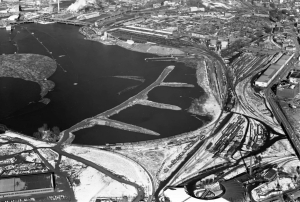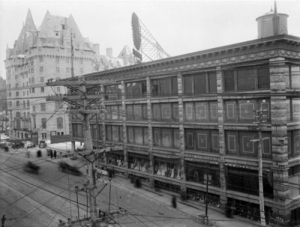Since September 2020, the Historical Society of Ottawa has presented a virtual speakers series using Zoom. A full recording of those presentations is available on the HSO YouTube channel and shown here as well.
The Historical Society of Ottawa does not necessarily subscribe to views expressed in these videos, nor take any responsibility for their content.
Dave Allson: Ottawa’s Shoreline - Built from Garbage
Dave Allston is a ‘trash talker’. Specifically, on the afternoon of Saturday, January 27, 2024, he talked to the Historical Society of Ottawa at our first in-person presentation of 2024 on how the Ottawa River shoreline was reshaped during the early 1960s using garbage. Dave is the senior asset manager (heritage) at National Defence and also an author, columnist, researcher, and runs the blog, The Kitchissippi Museum. He was making his 3 rd presentation to the Society. The session, which was hosted by the Main Branch of the Ottawa Public Library, received a record turnout of 113 attendees, who were captivated by Dave’s account.
Dave explained to us that in 1959 the City of Ottawa was facing a major problem. The two municipal dumps, one on Riverside Drive and the other on Raven Road, were both reaching capacity and would need to be closed within two years. A solution was urgently needed. Likely inspired by Toronto’s redevelopment of their waterfront and similar work in other cities, in February 1959 the Ottawa Works Commissioner, Frank Ayers, recommended to the Board of Control that Nepean Bay, which lay just to the west of the current site of the Canadian War Museum, could be used as their new landfill site. The Board directed him to approach the National Capital Commission with the idea. Their response was immediate and enthusiastic. The NCC had envisaged creating a giant beach along the Ottawa River along with a large playground and other recreation facilities, but had no clear plan for how to proceed. The City’s proposal was approved in one week. The scheme, part of the NCC’s implementation of the Greber Plan, would eventually also encompass Lazy Bay just north of Laroche Park and Bayview Bay between the Lemieux Island Bridge and the Chief William Commanda Bridge.
The plan was simple. Build a causeway across the mouth of the bay that would both seal it off from the river and provide a roadway for the garbage trucks to dump their loads. They would then pump out the water from behind the causeway; the bay was only 4 or 5 feet deep. Ignore the many feet of water-rotted sawdust that covered the bottom of the bay, a by-product from the lumber industry. Then fill the whole thing with garbage, finally to be covered by rock and a thick layer of soil. Presto, 50 acres of new land created and a temporary end to the garbage crisis. Work commenced on the causeway in the early months of 1962 and the dump was opened during the week of March 4, 1963.
There would be a massive amount of rock required to build the causeway, which would extend west to Lazy Bay. Dave explained that fortunately, there were other major projects underway in Ottawa at that time, which both provided the necessary rock for the causeway and a convenient disposal solution for the other projects. Tunnelling for the Ottawa Interceptor and Outfall Sewer project would create millions of tons of rock. The tunnels ran from Booth Street under Wellington past the Chateau Laurier and east through to the new sewage disposal plant at Green’s Creek. At this time, Ottawa pumped all its raw sewage directly into the Ottawa River. The new treatment plant would partially treat this sewage, the City feeling that it was not worth the additional expense to fully treat the sewage as the communities upstream continued to pump their sewage into the river untreated. A second excavation project to entrench what is now the OC Transpo’s Trillium Line and take it underneath Dow’s Lake, also provided rock for the causeway. Finally, the major excavation project involved in the construction of the National Arts Centre would provide the fill needed to cover all the garbage once the dump was full.
With the closure of the Riverside Drive landfill on March 9, 1963, all city garbage was sent to the new site, which was expected to have a lifespan of two years. The city even placed ads in the newspaper to encourage their citizens to bring their own garbage to the new dump. Dave revealed that there were other factors at play that would dramatically shorten the life of the new landfill. The National Capital Commission had begun an urban renewal project in LeBreton Flats in 1962 and as residents of the area moved away, their former homes and businesses remained empty. It didn’t take long until this proved to be a problem, encouraging squatters, cases of arson and a range of other undesirable activities. As such, the NCC began demolishing the structures as soon as they became vacant, and as the new city dump in Nepean Bay was handy, the remains were carted there. The result was that the dump filled quickly and was closed on February 1, 1964, less than a year after it opened.
By this time the NCC had abandoned their grandiose beach plans in favour of simple parkland, other uses, and a parkway, now known as the Kichi Zībī Mīkan. This meant excavation of thousands of tons of the recently buried garbage and transferring it west to either Bayview Bay or Lazy Bay. Although the parkway provided a scenic drive and a much needed west – east link, it also separated the communities from the river and areas that had traditionally formed part of their neighborhood.
Dave reminded us that this all happened over the span of a few years some 60 years ago and that today few are even aware that this took place. This is true even for some members of the National Capital Commission. As new development is proposed and eventually undertaken in these areas, such as the construction of a number of embassies on Lazy Bay Commons, do the planners know what to expect? Will the solution to our garbage crisis of 1959 come back to haunt us in the years ahead, and, as we face the same problem again, what lessons are to be learned from our response back then?
Earlier on the morning of January 27, 2024, CBO-FM featured an interview between Dave and the host of their program “In Town and Out”, Giacomo Panico. The interview carries additional information on the topic and can be heard at: Ottawa River shoreline made out of garbage | In Town and Out with Giacomo Panico | Live Radio | CBC Listen.
The Rise and Fall of the Daly Building
14 June 1905
One of the greatest heritage battles in Ottawa’s history was fought over the future of the Daly Building, a multi-storey, former department store cum government office building located in the block bounded by Mackenzie Avenue, Rideau Street and Sussex Avenue. The architectural and historic merits of the building, constructed in what is known as the “Chicago style,” were debated ad nauseam for years if not decades in Ottawa’s newspapers, at City Hall, and at the National Capital Commission. While all could agree that something had to be done with the aging building, what that something was sharply divided Ottawa residents. As it turned out, the building, which was vacated by its last tenants in 1978, was left empty for thirteen years as the federal government, the owner of the property, dithered. It was hastily demolished in 1991, amidst a huge outcry, after a renovation attempt fell through. Paralleling what happened with LeBreton Flatts, the land was then left fallow for more than a decade. After many different development concepts were advanced and discarded, the government finally leased the property to Claridge Homes for an up-scale condominium building that opened in 2005.
The edifice which was to become known as the Daly Building, was built in 1904-05 by the Clemow Estate, under the supervision of Mr. William F. Powell who managed the Estate’s business affairs. Powell had originally hoped to build a hotel on the site. (This was before the Château Laurier was constructed across the street.) But when his hotel plans fell through, Powell negotiated a deal with Thomas Lindsay, a prominent Ottawa merchant who owned T. Lindsay Company, a department store on Wellington Street, and Larose & Company on Rideau Street. Under the agreement, the Clemow Estate would build a modern, five-storey, department store building that Thomas Lindsay would lease.
In preparation for the project, Powell travelled to New York on a fact-finding mission about the large department stores of that city. He then engaged Moses C. Edey as architect. Edey was no stranger to Ottawa. Born in Wyman, Quebec, the Edey family had come to the Hull area in 1805 with Philemon Wright. Edey was the architect of the Aberdeen Pavilion at Lansdowne Park completed in 1898. For the new department store, Edey chose what was for the time a daring new form of architecture that relied on a steel and stone external framework that permitted the installation of large, plate-glass windows. There was so much external glass that the Evening Journal commented that the building should be called a “crystal palace.” There were no interior walls, allowing maximum flexibility to organize the space. Instead, the floors were supported by 32 steel columns clad in Portland cement. This “Chicago School” form of construction is considered to be the forerunner of the modern glass and steel office tower.
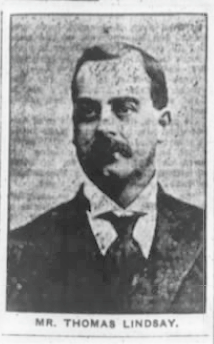 Thomas Lindsay, builder of what later would be known as the Daly Building, Ottawa Evening Journal, 15 June 1905.Ground was broken for the five-storey building (four storeys on the Mackenzie Avenue since the edifice was constructed on a slope) in the summer of 1904, and was completed a year later. The new Thomas Lindsay Company department store opened its doors for business on 14 June 1905.
Thomas Lindsay, builder of what later would be known as the Daly Building, Ottawa Evening Journal, 15 June 1905.Ground was broken for the five-storey building (four storeys on the Mackenzie Avenue since the edifice was constructed on a slope) in the summer of 1904, and was completed a year later. The new Thomas Lindsay Company department store opened its doors for business on 14 June 1905.
Thomas Lindsay, who had started the eponymous firm roughly fourteen years earlier at his Wellington Street location, was known for selling goods at low prices. His company was advertised as “The House of Bargains” and “the store where money has the greatest purchasing power.” But there was no stinting on the interior furnishings and fittings of his new department store. As well as having wide staircases, the store was serviced by three elevators, two for customers and one for freight. In addition to the natural lighting provided by the large plate glass windows, which were fitted with pivoting devices that permitted them to swivel open for easy cleaning and fresh air, the building was equipped with electric lighting. Around every other pillar on each floor was a large display table for goods. Every floor was serviced by a pneumatic tube, cash-carrying system, and had ladies’ and gentlemen’s toilets, all furnished with hot and cold running water. On the second floor overlooking Major Hill’s Park there was a large drawing room for visitors where they could go to sit, relax, read the latest magazines, or write letters. A ladies’ “retiring room” was off of this.
On opening day, only three floors were finished; the upper two floors were completed by the fall. On the ground floor, off of Sussex Street, there was the men’s and boy’s clothing departments, a grocery equipped with a three-compartment refrigerator, and a drug store. On the first floor (accessed through the Mackenzie Street entrance), were the ladies’ department, and a “small wares” department. There were offices the third floor. Home furnishings, carpets, and hardware were located on the upper two floors once they were completed.
In 1906, Thomas Lindsay Company bought the building, as well as an adjacent empty lot to the north of the original structure, and other nearby properties from the Clemow Estate for reportedly $350,000. Lindsay’s intention was to increase the floor space of the department store by adding two floors, as originally designed by the building’s architect, and by extending the building onto the empty lot. However, these plans were delayed, possibly due to Thomas Lindsay’s declining health. In 1909, Thomas Lindsay sold his controlling interest in the Thomas Lindsay Company to the Rea brothers of Toronto for $300,000; the business had become too much for him. He died shortly after the sale.
The Rea brothers had retail experience in Toronto, having sold a similar store there to Robert Simpson, the owner of Simpson’s Department Store. After a short delay, they changed the name of their new department store to the A.E. Rea Company. In 1913, they undertook the store’s expansion as originally envisage by Lindsay. Other changes included a shortened work week. No longer would employees start work at 7:30am. Instead there would be a nine-hour day beginning at 8.30am, running until 5:30pm. As well, a new money-back guarantee was introduced. Also changed was the advertising policy of the store. Thomas Lindsay had withdrawn all advertising from the Ottawa Citizen in early 1908 owing to the newspaper’s opposition to the City taking over the Metropolitan Company’s water power operations at Britannia. Lindsay, who was a major shareholder in the power company, favoured the sale. Lindsay’s ban on advertising in the Citizen was revoked when the Rea brothers purchased the store.
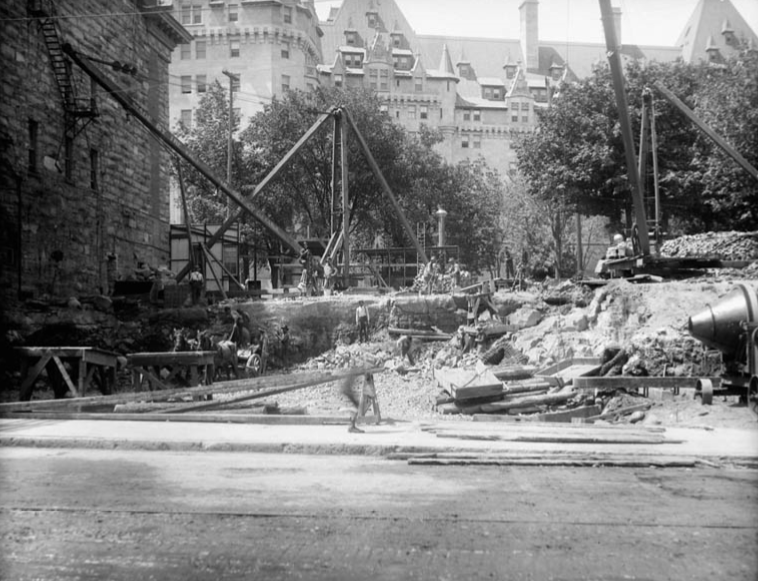 Construction of the Daly Building extension northward along Sussex Street. The Château Laurier Hotel is in the background, 1913, Library and Archives Canada, Topley Studios, ID #3410293.
Construction of the Daly Building extension northward along Sussex Street. The Château Laurier Hotel is in the background, 1913, Library and Archives Canada, Topley Studios, ID #3410293.
In late 1917, the Rea brothers, who had overextended themselves, ran into financial difficulty. Liquidators were called in to settle their affairs with the stock and assets of the department store sold off at 40 cents on the dollar. The big department store passed into the hands of H. J. Daly who took over the business and ownership of the building in February 1918.
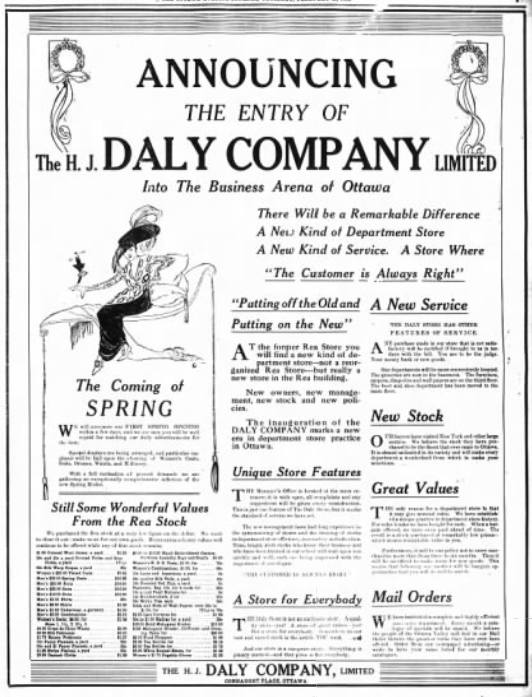 Advertisement that appeared in the Ottawa Journal 28 February, 1918.Oddly, for a building that bore his name for the rest of the century, Daly didn’t own it for very long—less than four years. In 1919, Daly moved his department store operations to a new store built on Sparks Street on a site previously occupied by the Arcade building (roughly where the CBC building is today) which had burnt down in a huge conflagration in December 1917. By mid-August 1919, the Daly Building was vacated and rented to the Federal Government which subsequently bought it for $1 million in late 1921. The H. J. Daly department store did not last long in its new Sparks Street location. It failed in early 1923.
Advertisement that appeared in the Ottawa Journal 28 February, 1918.Oddly, for a building that bore his name for the rest of the century, Daly didn’t own it for very long—less than four years. In 1919, Daly moved his department store operations to a new store built on Sparks Street on a site previously occupied by the Arcade building (roughly where the CBC building is today) which had burnt down in a huge conflagration in December 1917. By mid-August 1919, the Daly Building was vacated and rented to the Federal Government which subsequently bought it for $1 million in late 1921. The H. J. Daly department store did not last long in its new Sparks Street location. It failed in early 1923.
As for the Daly Building itself, it was the home of a variety of federal government departments over the next fifty plus years, starting with the Department of Health in 1919 and ending as the Customs and Excise training centre in 1978. Its last private-sector tenant was Ad Lib, a women’s clothing store.
Discussion about pulling down the building began in 1954 when Jacques Gréber, the noted French urban planner who advised the federal government on how to beautify the Capital, recommended replacing the Daly building with a three-floor parking garage with a park on top. His suggestion did not go over well with Mayor Charlotte Whitton. The Minister of Public Works announced that other departments needed the space and the idea quickly faded.
But by the late 1970s, the building was in poor condition. As well, past renovations, which included replacing the windows during the 1920s and the removal of the decorative cornice in 1964 over concerns that pieces might fall and hurt passing pedestrians, were not sympathetic to the original design. With lots of new federal office space just built in Hull, the Daly Building was surplus to requirements. The Department of Public Works announced that since it was not economic to renovate it, the building would be demolished in 1979.
This set off a huge fight between conservationists and demolishers within the federal government, architect associations, and the heritage community over the merits of the conserving the only example of “Chicago-style architecture” in the city. As the war of words raged, the building slowly deteriorated. On the side of saving the former department store were Ottawa mayor Marion Dewar, and Jean Pigott, for a time the Chair of the National Capital Commission in the mid-1980s. Heritage Ottawa and a dedicated lobby group called Friends of the Daly Building also called for its restoration. Others, however, applauded its demolition. Charles Lynch, the noted Canadian journalist, author, and one-time former governor of Heritage Ottawa called the Daly Building “an ugly duckling: a former failed department store, failed office building, and successful eyesore.” He opined that the structure offered nothing of note or of beauty, either outside or inside, and he would be “honoured to strike the first blow when the wreckers come.” Another commentator wrote that the “heritage movement risked “making a fool of itself by unwise support of an unworthy cause.” He argued that to spend millions to “create a museum for architects when the general population hated the building was a form of “elitism.”
The hammer finally came down in September 1991 when the National Capital Commission announced that it didn’t believe that a group of developers (Coopdev and its partner Duroc Enterprises) would be able to finish a planned $45 million renovation by September the following year owing to the developers’ inability to find a major tenant for the renovated structure. When Coopdev failed to pay its first $60,000 payment in monthly rent on its 66-year lease, the NCC fired the company. The Daly Building was hastily demolished just a few days later.
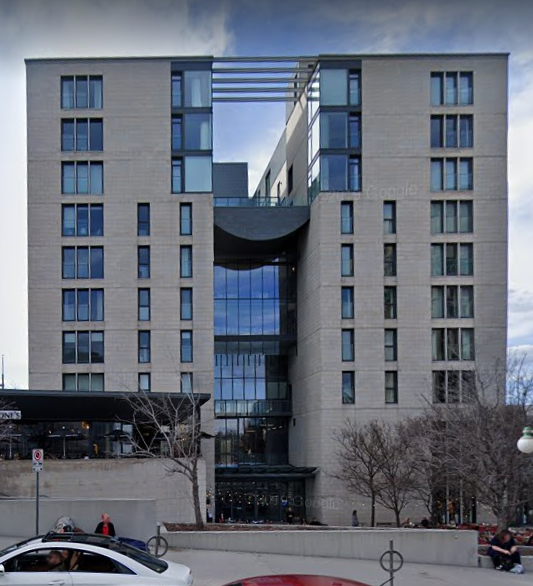 700 Sussex Street, site of the “Daly Building,” Google Maps, May 2019.Over the following fourteen years, suggestions came and went on what to do with the property. Should it be a park, a parking garage, or some new prestige project? One idea that gained some traction for a while was to build a performing arts centre to celebrate Canada’s Indigenous peoples. Noted Canadian architect, Douglas Cardinal, reportedly agreed to design the centre. The idea flopped. In the late 1990s, Gateway Development Corp. proposed building an upscale hotel on the site, with retail stores on the ground level, loft apartments, and, believe it or not, an underground aquarium. The proposal failed to receive the necessary financial backing and the project collapsed.
700 Sussex Street, site of the “Daly Building,” Google Maps, May 2019.Over the following fourteen years, suggestions came and went on what to do with the property. Should it be a park, a parking garage, or some new prestige project? One idea that gained some traction for a while was to build a performing arts centre to celebrate Canada’s Indigenous peoples. Noted Canadian architect, Douglas Cardinal, reportedly agreed to design the centre. The idea flopped. In the late 1990s, Gateway Development Corp. proposed building an upscale hotel on the site, with retail stores on the ground level, loft apartments, and, believe it or not, an underground aquarium. The proposal failed to receive the necessary financial backing and the project collapsed.
The NCC finally reached a deal with Claridge Homes and its president Bill Malhotra, under which the developer would lease the site for 66 years and build an eleven-storey condominium building with an open-air roof deck and garden on the eighth floor. The 70 luxury apartments ranged in size from roughly 1,000 to 2,300 square feet in size. The price for the one of the penthouse suites reportedly topped $1.75 million… and this was in 2002! Despite the eye-watering prices, 700 Sussex Drive proved to be a great success and quickly sold out.
While the old Daly department store is now long gone, its spirit is still with us. Dan Hanganu, the architect for the new condominium development, apparently drew his design inspiration from the old department store.
Sources:
Heritage Ottawa, Daly Building, https://heritageottawa.org/50years/daly-building.
Ottawa Citizen, 1905. “Clemow Estate,” 12 June.
——————, 1905. “Opening Of Ottawa’s New Palatial Store,” 10 June.
——————, 1905. “Congratulations,” 15 June.
——————, 1909. “Control May Change Hands,” 3 August.
——————, 1909. “The Lindsay Sale,” 7 August 1909.
——————, 1909. “Style Center Of Canada,” 18 August.
——————, 1909. “A Bit Of Local History,” 20 August.
——————, 1909. “Shorter Hours For Employes (sic),” 25 August.
——————, 1954. “Mayor Calls Greber Parking Plan Speculative Newspaper Story,’” 14 September.
——————, 1985. “An Argument for preservation of the Chicago Style Daly Building,” 16 November.
——————, 1991. “A Thing of the past,” 5 September.
——————, 1991. “Why doom the Daly building now?,” 7 September.
——————, 1991. “Start the Demolition!,” 8 September 1991.
——————, 1991. “Heritage falls off the Day tightrope,” 20 October.
——————, 1999. “Remembering the Daly Building,” 15 August.
——————, 2002, “Long lineup for Luxury Daly Units,” 9 January.
Ottawa Evening Journal, 1904. “Palace Store on Clemow Site,” 13 June.
—————————–, 1905 “Many Expressions of Good Will From Many Friends,” 15 June.
—————————–, 1918. “The Rea Store, Announcement Extraordinary,” 5 January.
—————————–, 1921. “Property Transfers For Large Amounts,” 2 November.
Story written by James Powell, the author of the blog Today in Ottawa's History.
Retired from the Bank of Canada, James is the author or co-author of three books dealing with some aspect of Canadian history. These comprise: A History of the Canadian Dollar, 2005, Bank of Canada, The Bank of Canada of James Elliott Coyne: Challenges, Confrontation and Change,” 2009, Queen’s University Press, and with Jill Moxley, Faking It! A History of Counterfeiting in Canada, 2013, General Store Publishing House, Renfrew, Ontario. James is a Director of The Historical Society of Ottawa.
Arrested Development
If you missed the HSO presentation by Phil Jenkins (or you just want to watch again) check out his recap and reflections on the history of LeBreton Flats in this video from April 14, 2021.



